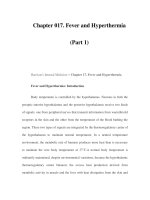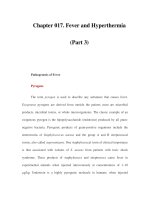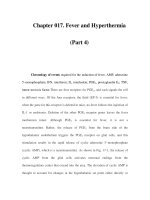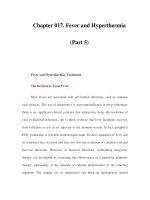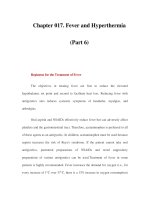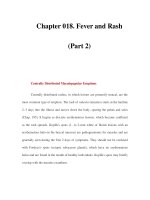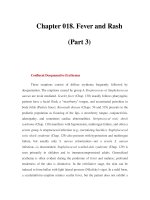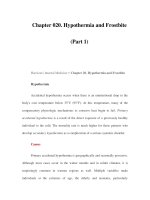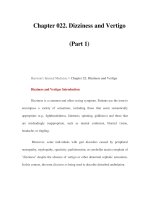Chapter 017. Fever and Hyperthermia (Part 1) docx
Bạn đang xem bản rút gọn của tài liệu. Xem và tải ngay bản đầy đủ của tài liệu tại đây (14.57 KB, 5 trang )
Chapter 017. Fever and Hyperthermia
(Part 1)
Harrison's Internal Medicine > Chapter 17. Fever and Hyperthermia
Fever and Hyperthermia: Introduction
Body temperature is controlled by the hypothalamus. Neurons in both the
preoptic anterior hypothalamus and the posterior hypothalamus receive two kinds
of signals: one from peripheral nerves that transmit information from warmth/cold
receptors in the skin and the other from the temperature of the blood bathing the
region. These two types of signals are integrated by the thermoregulatory center of
the hypothalamus to maintain normal temperature. In a neutral temperature
environment, the metabolic rate of humans produces more heat than is necessary
to maintain the core body temperature at 37°C.A normal body temperature is
ordinarily maintained, despite environmental variations, because the hypothalamic
thermoregulatory center balances the excess heat production derived from
metabolic activity in muscle and the liver with heat dissipation from the skin and
lungs. According to studies of healthy individuals 18–40 years of age, the mean
oral temperature is 36.8° ± 0.4°C (98.2° ± 0.7°F), with low levels at 6 A.M. and
higher levels at 4–6 P.M. The maximum normal oral temperature is 37.2°C
(98.9°F) at 6 A.M. and 37.7°C (99.9°F) at 4 P.M.; these values define the 99th
percentile for healthy individuals. In light of these studies, an A.M. temperature of
>37.2°C (>98.9°F) or a P.M. temperature of >37.7°C (>99.9°F) would define a
fever. The normal daily temperature variation is typically 0.5°C (0.9°F). However,
in some individuals recovering from a febrile illness, this daily variation can be as
great as 1.0°C. During a febrile illness, the diurnal variation is usually maintained
but at higher, febrile levels. The daily temperature variation appears to be fixed in
early childhood; in contrast, elderly individuals can exhibit a reduced ability to
develop fever, with only a modest fever even in severe infections.Rectal
temperatures are generally 0.4°C (0.7°F) higher than oral readings. The lower oral
readings are probably attributable to mouth breathing, which is a factor in patients
with respiratory infections and rapid breathing. Lower-esophageal temperatures
closely reflect core temperature. Tympanic membrane (TM) thermometers
measure radiant heat from the tympanic membrane and nearby ear canal and
display that absolute value (unadjusted mode) or a value automatically calculated
from the absolute reading on the basis of nomograms relating the radiant
temperature measured to actual core temperatures obtained in clinical studies
(adjusted mode). These measurements, although convenient, may be more variable
than directly determined oral or rectal values. Studies in adults show that readings
are lower with unadjusted-mode than with adjusted-mode TM thermometers and
that unadjusted-mode TM values are 0.8°C (1.6°F) lower than rectal
temperatures.In women who menstruate, the A.M. temperature is generally lower
in the 2 weeks before ovulation; it then rises by ~0.6°C (1°F) with ovulation and
remains at that level until menses occur. Body temperature can be elevated in the
postprandial state. Pregnancy and endocrinologic dysfunction also affect body
temperature
Fever versus Hyperthermia
Fever
Fever is an elevation of body temperature that exceeds the normal daily
variation and occurs in conjunction with an increase in the hypothalamic set point
(e.g., from 37°C to 39°C). This shift of the set point from "normothermic" to
febrile levels very much resembles the resetting of the home thermostat to a higher
level in order to raise the ambient temperature in a room. Once the hypothalamic
set point is raised, neurons in the vasomotor center are activated and
vasoconstriction commences. The individual first notices vasoconstriction in the
hands and feet. Shunting of blood away from the periphery to the internal organs
essentially decreases heat loss from the skin, and the person feels cold. For most
fevers, body temperature increases by 1°–2°C. Shivering, which increases heat
production from the muscles, may begin at this time; however, shivering is not
required if heat conservation mechanisms raise blood temperature sufficiently.
Nonshivering heat production from the liver also contributes to increasing core
temperature. In humans, behavioral adjustments (e.g., putting on more clothing or
bedding) help raise body temperature by decreasing heat loss.
The processes of heat conservation (vasoconstriction) and heat production
(shivering and increased nonshivering thermogenesis) continue until the
temperature of the blood bathing the hypothalamic neurons matches the new
thermostat setting. Once that point is reached, the hypothalamus maintains the
temperature at the febrile level by the same mechanisms of heat balance that
function in the afebrile state. When the hypothalamic set point is again reset
downward (in response to either a reduction in the concentration of pyrogens or
the use of antipyretics), the processes of heat loss through vasodilation and
sweating are initiated. Loss of heat by sweating and vasodilation continues until
the blood temperature at the hypothalamic level matches the lower setting.
Behavioral changes (e.g., removal of clothing) facilitate heat loss.A fever of
>41.5°C (>106.7°F) is called hyperpyrexia. This extraordinarily high fever can
develop in patients with severe infections but most commonly occurs in patients
with central nervous system (CNS) hemorrhages. In the preantibiotic era, fever
due to a variety of infectious diseases rarely exceeded 106°F, and there has been
speculation that this natural "thermal ceiling" is mediated by neuropeptides
functioning as central antipyretics.In rare cases, the hypothalamic set point is
elevated as a result of local trauma, hemorrhage, tumor, or intrinsic hypothalamic
malfunction. The term hypothalamic fever is sometimes used to describe elevated
temperature caused by abnormal hypothalamic function. However, most patients
with hypothalamic damage have subnormal, not supranormal, body temperatures.
